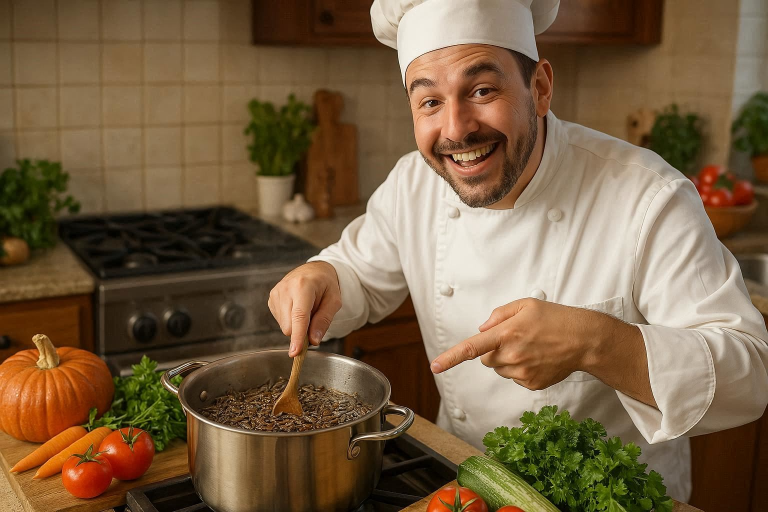Wild rice is an often-overlooked grain that packs a punch in both flavor and nutrition. It’s more than just a side dish—wild rice adds a nutty flavor, a chewy texture, and a hearty quality to any meal. However, getting it to the perfect level of fluffiness can be tricky if you’re not familiar with the nuances of cooking it. Whether you’re a seasoned chef or a beginner in the kitchen, this guide will walk you through every step of how to cook wild rice to ensure it turns out just right. We’ll cover everything from the water-to-rice ratio to soaking, cooking times, and even serving suggestions. Let’s dive into making your wild rice as perfect as possible!
What Makes Wild Rice So Special?
Wild rice isn’t actually rice at all! It’s technically a grass seed that grows in lakes and rivers. With its long grains, chewy texture, and nutty flavor, it stands apart from traditional white rice, making it a popular choice for anyone looking to add a little more depth to their meals. Wild rice is not only a tasty addition to dishes, but it’s also incredibly nutritious. It’s rich in fiber, antioxidants, and protein, making it a great option for anyone looking to up their healthy eating game.
While wild rice can be a fantastic ingredient, cooking it perfectly can sometimes be a challenge. It’s more difficult to get the exact right texture compared to white rice, but don’t worry—once you know the ins and outs of cooking wild rice, you’ll be able to whip it up with ease and get that perfect, fluffy texture every time.
In this guide, we’ll answer all your burning questions and offer tips to ensure that your wild rice is cooked just the way you like it.
What is the Ratio of Wild Rice to Water?
The water-to-rice ratio is crucial when cooking wild rice. The right balance ensures that your rice is tender and fluffy, not too soggy or too dry.
The Importance of the Right Ratio:
Wild rice has a unique texture that benefits from a larger amount of water compared to regular white rice. If you use too little water, the rice will be undercooked and tough; too much water and it will become mushy. Getting the Guide to Mastering Everyday Cooking balance right is key!
Standard Ratio:
The typical ratio for cooking wild rice is 1 cup of wild rice to 3 cups of water. This is the standard method for most cooking styles, but there can be slight variations based on the type of wild rice or the cooking method you choose.
How it Varies:
Some varieties of wild rice, such as quick-cooking wild rice, might require a slightly different ratio, so always check the package instructions if you’re using a pre-packaged variety. For traditional wild rice, the 1:3 ratio works best for a fluffy, tender result.
Does Wild Rice Need to Be Soaked Before Cooking?
Soaking wild rice is a common practice, but it’s not always necessary. Let’s break down the pros and cons of soaking before cooking.
Soaking vs. Not Soaking:
- Soaking wild rice can help reduce the cooking time and allows the grains to expand fully, which can lead to a fluffier texture.
- No Soaking: While soaking can improve texture, it’s not required. You can skip this step if you prefer to cook wild rice without pre-soaking, but be prepared for a longer cooking time.
Why Soak?
Soaking wild rice can help the grains cook more evenly and reduce the cooking time by 10-15 minutes. It also helps the rice become more tender, giving it that delightful chewy texture. If you’re short on time, soaking wild rice for 2-4 hours (or overnight) will speed up the process.
How to Soak:
- Short Soak (2-4 hours): Place the wild rice in a bowl, cover it with water, and let it soak.
- Long Soak (overnight): If you’re prepping ahead, soak the rice overnight in the refrigerator. Drain it before cooking.
If you decide not to soak, expect a slightly longer cooking time (around 50-60 minutes instead of 45 minutes).
How Long Do You Cook Wild Rice for Compared to White Rice?
One of the key differences between wild rice and white rice is the cooking time. Wild rice takes considerably longer to cook due to its tough outer husk, which makes it more resistant to absorbing water and cooking through.
Cooking Time Difference:
- Wild Rice: Typically, wild rice will need about 45-60 minutes to cook fully, depending on the size of the batch and whether or not it was soaked.
- White Rice: In contrast, white rice only takes 15-20 minutes to cook.
Check for Doneness:
The best way to check if wild rice is done is to taste it. It should be tender but still chewy. If you find it too firm or crunchy, add a little more water and continue cooking.
Should Wild Rice Be Cooked, Covered or Uncovered?
Cooking wild rice covered or uncovered can significantly affect the texture of the final dish. Here’s a quick breakdown of when to cover it and when to leave it uncovered.
Cooking Covered:
Covering the wild rice during the cooking process helps retain steam and moisture, leading to more even cooking. This is particularly important for wild rice, as it helps the grains cook evenly and prevents them from drying out. Covering the pot is the preferred method for most people.
When to Uncover:
If you find that there’s still too much water left after the rice is tender, uncover the pot and let the excess liquid evaporate. This helps avoid soggy rice. It’s also a good idea to uncover the rice for the last few minutes if you want a slightly firmer texture.
Final Texture:
In summary, cook wild rice covered to trap the steam, and uncover it at the end to let any excess water evaporate for the perfect final texture.
Tips for Perfectly Cooking Wild Rice
Here are a few extra tips to ensure your wild rice turns out perfectly every time:
Using the Right Pot:
A large pot with a tight-fitting lid is essential for cooking wild rice evenly. The lid helps trap the steam, ensuring all the grains cook through without losing moisture. Make sure the pot is big enough to allow the rice to expand as it cooks.
Adding Flavor:
Wild rice has a great natural flavor, but it can be enhanced with a few simple additions. You can add herbs like thyme or rosemary, or even a dash of salt to the cooking water for extra flavor. For a more complex taste, try adding a splash of soy sauce or a squeeze of lemon juice.
Resting the Rice:
Once the rice is cooked, let it rest for 5-10 minutes with the lid on. This allows any remaining moisture to distribute evenly, giving the rice the perfect texture.
Serving Suggestions for Wild Rice
Now that you’ve perfected your wild rice, here are a few ways to incorporate it into your meals:
Side Dish Ideas:
Wild rice pairs beautifully with roasted meats like chicken, turkey, or beef. It’s also great as a base for vegetable dishes. Try it as a side to a hearty stew or a baked chicken casserole.
Using Wild Rice in Soups and Casseroles:
Wild rice adds texture and flavor to soups, stews, and casseroles. Use it as a substitute for white rice in any recipe that calls for rice, and it will bring a nutty, hearty quality to your dishes.
Combining with Other Grains:
Wild rice can also be combined with other grains, such as quinoa or brown rice, to make a nutritious, filling salad. This is a great way to use up leftovers and add variety to your meals.
FAQs
What is the ratio of wild rice to water?
The standard ratio for cooking wild rice is 1 cup of wild rice to 3 cups of water. This ensures that the rice has enough moisture to cook fully and become tender.
Does wild rice need to be soaked before cooking?
Soaking wild rice is optional but can help reduce cooking time and ensure a more even texture. If you choose to soak it, soak for 2-4 hours or overnight for best results. If you prefer not to soak, just increase the cooking time.
How long do you cook wild rice compared to white rice?
Wild rice takes 45-60 minutes to cook, while white rice only takes about 15-20 minutes. Wild rice has a tougher outer husk, which requires more time to cook through.
Should wild rice be cooked covered or uncovered?
Wild rice should generally be cooked covered to retain moisture and ensure even cooking. You can uncover it towards the end if there’s excess water to evaporate.
How do I know when wild rice is done?
Wild rice is done when it’s tender but still chewy. Check the grains for doneness by tasting a few. If they’re still firm, continue cooking with a bit more water.
Can I cook wild rice in a rice cooker?
Yes, you can cook wild rice in a rice cooker. Use the same 1:3 ratio of rice to water and cook on the “white rice” setting. Check for doneness and add more water if needed.
How do I store cooked wild rice?
Once cooked, wild rice can be stored in an airtight container in the refrigerator for up to 5 days. For longer storage, you can freeze it in a freezer-safe bag for up to 6 months.
Can I season wild rice while cooking?
Yes! Wild rice absorbs flavors well. Add herbs, spices, or a pinch of salt to the water while cooking to infuse extra flavor. Garlic, rosemary, or bay leaves work well.
Conclusion
Cooking wild rice is all about the right balance of water, cooking time, and patience. By following the correct ratio, soaking if desired, and allowing the rice to rest afterward, you can create wild rice that’s perfectly fluffy and full of flavor every time. Whether you’re serving it as a side dish, incorporating it into a soup, or adding it to a salad, wild rice is a versatile and nutritious addition to any meal. Experiment with different seasonings and flavor combinations to make your wild rice dishes truly unique!
Call to Action
Have your own favorite wild rice recipes or cooking tips? Share them in the comments below! If you found this guide helpful, be sure to share it on social media and help others learn how to cook wild rice to perfection. Also, check out our other rice recipes and tips for more culinary inspiration! Happy cooking!

